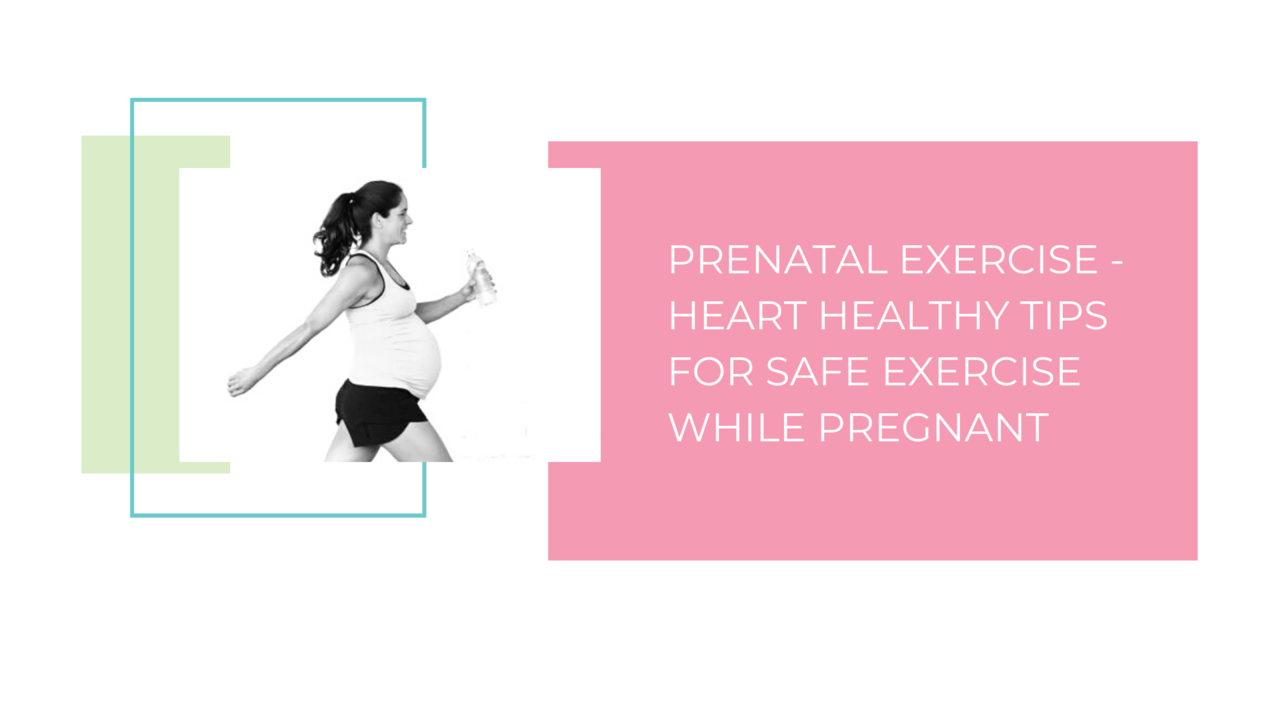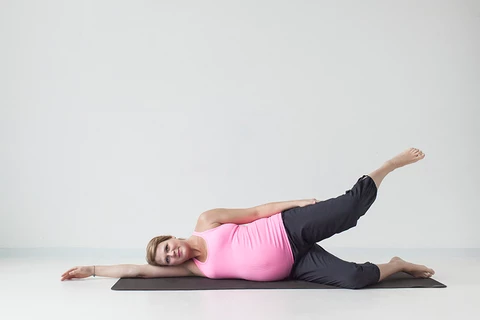
Prenatal Exercise - Heart Healthy Tips for Safe Exercise while Pregnant
Jan 08, 2020
How to Exercise While Pregnant
Everyone knows the benefits of exercise. Pregnancy is a time when exercise is key, not only for mom but for the benefit of babe' too!
How Exercise Benefits Your Baby
An exercise physiologist named Linda May looked at the benefits of exercise on the fetuses of 66 pregnant women. She and her partners collected non-invasive fetal heart measurements at 28, 32 and 36 weeks of gestation.
The exercise group participated in moderate to vigorous exercise at least three times a week while the other group did not exercise. The team noticed changes in heart rate response in the fetuses of the exercising moms starting at 32 weeks and by 36 weeks they noticed lower heart rates and increased heart rate variability (an indicator of a heart functioning more efficiently and a measure typically associated with exercisers).
How Exercise Can Prepare You For Birth
There is a principle in fitness called the specificity principle. It states that the best way to develop physical fitness for your event or activity is to train the body as closely as possible to the way it will be used then. Thus, the best way to train for running is to run, for swimming it is to swim, and for weightlifting is to lift. So, what about birth?
Birth is a very physical event, but you can’t practice giving birth – so what’s a pregnant woman to do?
You can prepare your body for birth using exercises that mimic labour and birth positions. During pregnancy, if you incorporate labour and birth-specific movements into your workouts, you will prepare your body for when you are actually in labour and be better able to handle the physical demands of certain positions.
The Best Ways to Exercise While Pregnant
Exercise is better for mom and better for babe, but which exercises are safest and the best choice to get mamas movin’ when pregnant, while also being pelvic floor friendly and preparing you for birth?
Here are The Fitness Doula’s Top Tips for Heart-Healthy Exercise While Pregnant.
Walking
Walking is one of my favourite exercises for pregnancy – especially if your route has some hills. It is great for cardio, great for your glutes and legs (which we want to prepare for upright positions in labour) and great for your pelvic floor!
I recommend walking for 30 minutes every day. You should be able to carry on a conversation without becoming out of breath while you walk.
Swimming
The buoyancy offered by a pool can be such a welcome relief to the pregnant body, not to mention the gentle resistance offered by the water, which allows you to get your heart rate up as well! Swimming is a great low (read ‘no’) impact exercise that involves the whole body.
Keep in mind you can also get a great workout in the pool without doing laps. You can get a great glute and leg workout by standing at the edge of the pool, holding the side and swinging one leg forward and back. You can add paddles to your hands and while standing in water between hip and chest height, swing your arms through the water.
Gentle, no-impact cardio will benefit your heart, your core and your pelvic floor!
Squatting
Squatting is one of the positions I recommend for labour because it uses gravity and it opens up the pelvic outlet making more room for your baby, therefore facilitating the process of delivery.
During pregnancy, you need to build up your strength so that you are able to best use this position during labour. Squatting daily is ideal and can be done in a slow and controlled manner, or a bit more dynamically, which will increase the heart rate.
You can place a ball behind your low back against a wall and slowly ride the ball down the wall. You can hook a yoga strap around a monkey bar and hold on to the strap with both hands using the resistance to keep you in great form. Or you can do a free squat with no support.
Pay attention to your form – keep your tailbone untucked, hinge from the hips and ensure your knees do not glide forward over the toes. Inhale down and exhale up.
Squatting is great for your pelvic floor and it is typically most engaged just before you press back up. If you can add in a voluntary pelvic floor contraction just before you start to press back up and hold it as you do so, you will be training your pelvic floor AND your heart!
Hovering

This exercise may be called by several names, but hovering is the term I use after learning the Pfilates method. Hovering is a great pelvic floor exercise, a good glute builder, a great inner thigh toner. It encourages space in the pelvis for birth and prepares you for labour and birth positions that have you kneeling or on all fours.
Start with your knees a little wider than hip-width apart. Bring your toes to touch behind you, your hands on your hips and rest your bum on your heels to start.
Inhale to expand, then exhale to engage your core using pursed lips and your best core cue as you lift your bum away from your heels and come up to a kneeling position (see photo). Inhale as you lower back down. Repeat 10x and do 1-2 sets/per day.
Incorporating the movement into a supported forward lean using the stability ball allows you to build strength and endurance in a supported position while also using gravity.
Hovering is also a great restorative exercise postpartum. I generally recommend adding this exercise back in at around week 5 or 6 and you can modify the width of your knees depending on how you feel.
Side-Lying Bent Leg Raises

The side-lying birth position is one of the best in terms of preserving the perineum. It can also be used to slow things down if labour is progressing really quickly. You can be fully on your side or you can prop yourself up with pillows or the bed to angle your body slightly and get gravity helping out a bit too.
Lie on your side with both knees bent and ensure you have a gentle curve in your low back so your pelvis is in or as close to neutral as possible.
Inhale to expand, then exhale to engage your core using pursed lips and your best core cue as you lift the top leg up. Inhale as you lower back down.
In labour, you will have someone holding your leg for you but it still helps to have strength and endurance in a position that you may be in for a while.
You can also play around with the angle of your top leg – when you internally rotate your leg (the knee points slightly downward and the foot is more up) your pelvis actually opens a bit more which is key during labour and birth.
Postpartum, I would add this exercise in at week three or four.
Pelvic Rocking

If you don’t already have one, invest in a stability ball (also called a birth ball or an exercise ball). You can use it in pregnancy, in labour, and you will want one postpartum as it is one of the best ways to calm your little one. The gentle rhythm you find when holding your babe and gently bouncing up and down is good exercise for you and pure soothing bliss to your babe.
For this exercise, we won’t be bouncing but rather rocking (and rolling if you like). Sit in a neutral posture on the ball – neutral meaning you have a gentle curve in your low back and can feel the ball pressing into your perineum. You can place your hands on your hips or on the sides of the ball.
Keeping your upper body still, start to practice belly dance movements: thrust your hip to the left, then the right, then the left, then the… you get the picture.
You can do this quickly or slowly, but make the movement come from the pelvis, not the upper body. Now, come back to neutral and tuck the pelvis under and reach the sitz bones back, then under, then back… and so on.
You can then circle your pelvis on the ball in figure eights. Remember to change directions. Keeping mobility in the pelvis is key and when you take this movement into your labour you are encouraging a smoother passage for your babe into and out of your pelvis.
Postpartum, this exercise is better saved until six weeks or more once the perineum has healed and you feel comfortable sitting on the ball.
Core Breathing
Core breathing supports a healthy heart because it encourages you to breathe optimally, which in turn means better circulation and better oxygen delivery to you and your baby. It also promotes a calm, meditative state, which helps reduce stress and anxiety.
Listen to Your Body
Always pay close attention to how you feel and stop exercising if you feel:
- Dizziness
- Headache
- Chest pain
- Calf pain or swelling
- Abdominal pain
- Blurred vision
- Fluid leaking from the vagina
- Vaginal bleeding
- Less fetal movement
- Contractions
Staying fit and active while pregnant contributes to shorter pushing times in labour, a quicker recovery postpartum and increased confidence overall.
By choosing low or no impact activities that also raise the heart rate, moms will maintain a stronger core while building a happy healthy heart for themselves and their babe. And using specific exercises to prepare for labour and delivery will make you stronger in your pregnancy, optimize your birth, and support a smoother return to function postpartum.
Our Buff Muff App teaches you how to activate your pelvic floor appropriately and then add it to movement. There is a ton of free content available to anyone who downloads the app including a 7-day pelvic floor fitness challenge to introduce you to the concept of a whole-body fitness approach to pelvic health. Once the free challenge ends you have the option to join the membership for ongoing support from me, your very own vagina coach.
Click on the box below to check it out




